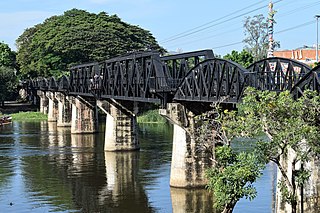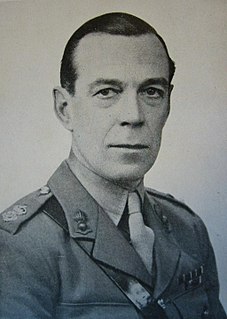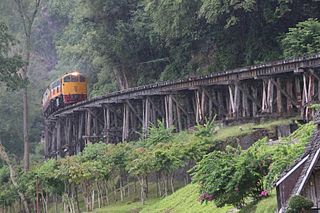
The Bridge on the River Kwai is a 1957 epic war film directed by David Lean and based on the 1952 novel written by Pierre Boulle. Although the film uses the historical setting of the construction of the Burma Railway in 1942–1943, the plot and characters of Boulle's novel and the screenplay are almost entirely fictional. The cast includes Alec Guinness, William Holden, Jack Hawkins, and Sessue Hayakawa.

The Burma Railway, also known as the Death Railway, the Siam–Burma Railway, the Thai–Burma Railway and similar names, is a 415 km (258 mi) railway between Ban Pong, Thailand and Thanbyuzayat, Burma, built from 1940 to 1943 by civilian labourers impressed or recruited by the Japanese and prisoners of war taken by the Japanese to supply troops and weapons in the Burma campaign of World War II. This railway completed the rail link between Bangkok, Thailand, and Rangoon, Burma. The name used by the Japanese Government is Tai–Men Rensetsu Tetsudō (泰緬連接鉄道), which means Thailand-Burma-Link-Railway.

Hellfire Pass is the name of a railway cutting on the former Burma Railway in Thailand which was built with forced labour during the Second World War, in part by Allied prisoners of war. The pass is noted for the harsh conditions and heavy loss of life suffered by its labourers during construction. It was called Hellfire Pass because the sight of emaciated prisoners labouring by burning torchlight resembled a scene from Hell.

Kanchanaburi is a town municipality in the west of Thailand and part of Kanchanaburi Province. In 2006 it had a population of 31,327. That number was reduced to 25,651 in 2017. The town covers tambons Ban Nuea and Ban Tai and parts of Pak Phraek and Tha Makham, all of Mueang Kanchanaburi District, and parts of tambon Tha Lo of Tha Muang District. Kanchanaburi lies 123 km west of Bangkok.

Kanchanaburi is the largest of the western provinces (changwat) of Thailand. The neighboring provinces are Tak, Uthai Thani, Suphan Buri, Nakhon Pathom, and Ratchaburi. In the west it borders Kayin State, Mon State, and the Tanintharyi Region of Myanmar.

The River Kwai, more correctly Khwae Noi or Khwae Sai Yok, is a river in western Thailand. It rises to the east of the Salween in the north-south spine of the Bilauktaung range near, but not over the border with Burma. It begins at the confluence of Ranti, Songkalia and Bikhli Rivers. At Kanchanaburi it merges with the Khwae Yai River to form the Mae Klong River, which empties into the Gulf of Thailand at Samut Songkhram.

The JEATH War Museum is a war museum in Kanchanaburi, Thailand about the Death Railway built from 1942 to 1943 by Allied POWs under the direction of the Japanese, a part of the Thai-Burma railways.

Brigadier Sir Philip John Denton Toosey was, as a Lieutenant Colonel, the senior Allied officer in the Japanese prisoner-of-war camp at Tha Maa Kham in Thailand during World War II. The men at this camp built Bridge 277 of the Burma Railway as later fictionalized in the book The Bridge over the River Kwai by Pierre Boulle, and since adapted into the Oscar-winning film The Bridge on the River Kwai in which Alec Guinness played the senior British officer, Lt Col Nicholson. Both the book and film outraged former prisoners because Toosey did not collaborate with the enemy, unlike the fictional Lt Col Nicholson.

The Bridge over the River Kwai is a novel by the French novelist Pierre Boulle, published in French in 1952 and English translation by Xan Fielding in 1954. The story is fictional but uses the construction of the Burma Railway, in 1942–1943, as its historical setting, and is partly based on Pierre Boulle's own life experience working in Malaysia rubber plantations and later working for allied forces in Singapore and Indochina during World War II. The novel deals with the plight of World War II British prisoners of war forced by the Imperial Japanese Army to build a bridge for the "Death Railway", so named because of the large number of prisoners and conscripts who died during its construction. The novel won France's Prix Sainte-Beuve in 1952.

Nam Tok Sai Yok Noi is a small town in Sai Yok District, Kanchanaburi Province, Thailand, along the route of the Death Railway linking Thailand with Burma. It is named after Sai Yok Noi Waterfall of Sai Yok National Park. During World War II, the small town was known as Tarsoa or Tarsau.

Mueang Kanchanaburi is the capital district of Kanchanaburi province, central Thailand.

The Khwae Yai River, also known as the Si Sawat, is a river in western Thailand. It has its source in the Tenasserim Hills and flows for about 380 kilometres (240 mi) through Sangkhla Buri, Si Sawat, and Mueang Districts of Kanchanaburi Province, where it merges with the Khwae Noi to form the Mae Klong River at Pak Phraek.

Ban Song Karia, also spelled Songkalia (ซองกาเลีย) and alternatively known as Songkurai, is a village in the Sangkhla Buri District of the Kanchanaburi Province, Thailand near the border with Myanmar at the Three Pagodas Pass. It was the location of three World War II Japanese Prisoner of War Camps located about 13 kilometres (8.1 mi) south of the Thai/Burma border.

Major Arthur Moon was an Australian army doctor who saved the lives of dozens of Far East prisoners of war as the Thailand-Burma Railway was being constructed during World War II.

The Thanbyuzayat War Cemetery is a prisoner of war cemetery for victims of Japanese imprisonment who died building the Death Railway in Burma. It is at the Burmese end of the Second World War railway construction, in Thanbyuzayat, 65 kilometres south of Mawlamyine (Moulmein). Thanbyuzayat is considered the terminus of the Death Railway, and is where it connected with the Burmese main line.

Chungkai War Cemetery, also known as Chung Kai War Cemetery, is a war cemetery in Tha Ma Kham near Kanchanaburi, Thailand. Established in the 1950s, the cemetery hosts the graves of 1,426 British and 313 Dutch prisoners of war who died during World War II. It was originally a prisoner of war camp on the Burma Railway.

The Wang Pho Viaduct, is a railway bridge made of wooden trestles which follow the cliff along the Khwae Noi River. The Wang Pho viaduct was constructed by allied prisoners of war of the Japanese during World War II as part of the Burma Railway. It is sometimes referred as the Double Viaduct, because of a nearby smaller viaduct. The viaduct is still in use and can be reached from the Wang Pho railway station.

Tha Khanun is a town and subdistrict (tambon) of Thong Pha Phum district of the Kanchanaburi Province, Thailand. It is named after the Jackfruit tree, and is located on the Khwae Noi River. Lam Khlong Ngu National Park and Wat Tha Khanun, a large Buddhist temple, are located near the town.

Konkoita is a former prisoner of war camp in the Sangkhla Buri District of the Kanchanaburi Province, Thailand. Located near the Karen village of Ban Kroeng Kruai, it was the location where the two sides of the Burma Railway met on 17 October 1943 at 262.87 kilometres from the starting point in Thailand. Konkoita and neighbouring villages were flooded in June 1984 by the construction of the Vajiralongkorn Dam. The population in the area was resettled several kilometres from the original villages.

Nong Lu is a sub-district (tambon) of Sangkhla Buri district of Kanchanaburi province, Thailand. The name is Karen and refers to the palm used for roofing. It is located near the border with Myanmar. Nong Lu covers the main town of the district, which is often known by the district's name as Sangkhlaburi (สังขละบุรี); the municipality is officially known as Wangka (วังกะ).






















